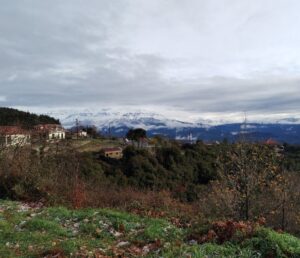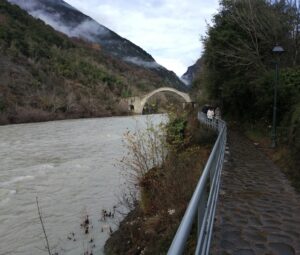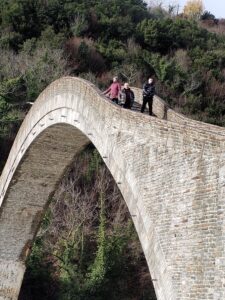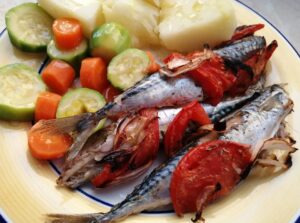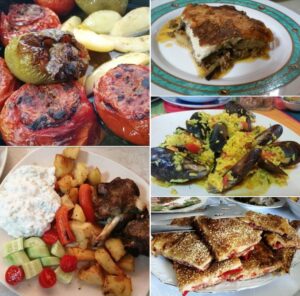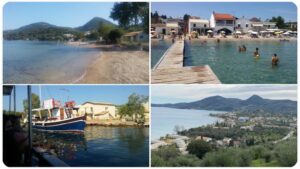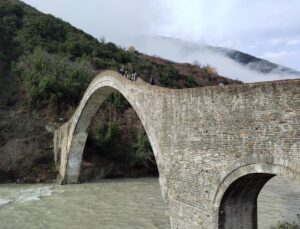 The most intrepid thing I’ve done in ages…
The most intrepid thing I’ve done in ages…
During my Christmas break in Epirus where my husband and I stayed in the historic city of Arta, we visited the mountain area of Tzoumerka for a day. Our first stop was the famous stone bridge of Plaka dating from 1866.
An earlier attempt to build it was made in 1863, but the bridge had collapsed on the day of its inauguration!
During WWII, it was bombed by the Germans near its centre but the damage was easily repaired.
This bridge is the biggest of its kind in the Balkans and the third biggest in Europe. The arch is 40 metres (130 ft) wide and 17.61 m (57 ft 9 in) high.
This marvelous single-arch stone bridge was demolished in February 1, 2015 during a flood caused by a heavy rainfall. Only a small bit on either side remained, only what touched the ground. The rest of the bridge, all parts that hovered in the air, collapsed.
It was on the news in Greece at the time, and everyone got upset about it, seeing that the stone bridges of Tzoumerka, just like those in Zagori, are legendary, unique in their mastery, and it’s not easy to replicate these nowadays.
Still, the architects and engineers at the Athens Polytechnic University stepped in, worked diligently, and were able to reconstruct this magnificent bridge, while trying their best to make it look as similar as possible to the original one.
The undertaking was huge. The university team comprised of 30 professors and 40 researchers. Committed to reconstructing the bridge just as it was originally, they used no modern technology, no hidden supports, and not a single kilo of metal.
As I admired it during my visit, I was particularly impressed by the coloring of the stone. It doesn’t look at all brand new, as one would expect. In fact, if one looks at pictures before and after the collapse, the sight is identical!
The bridge was given back to the public in 2020, a little over five years since its destruction.
I was thrilled on the day of my visit to find out that I was actually traveling on the coach with one of the people who had made the reconstruction of the bridge possible! That person was a reporter who works in one of the major Athens newspapers. She read a published article of hers to everyone on the coach, which she’d written about the bridge of Plaka, as we made our way there on the mountains.
It was a treat for everyone to listen to her article as we traveled up and down on windy mountain roads, amidst a lush landscape that was crowned with heavily snowcapped mountains and thick cloud formations.
At the end of her beautiful and highly descriptive article, the lady reporter informed us that she had last visited the bridge a few days before it collapsed. She had taken several photographs that day, and, would you believe, those wound up playing an integral part in the reconstruction of the bridge!
This is because when the professors at the Athens Polytechnic University heard about her article they contacted her, hoping to acquire photographs of the bridge, so they could reconstruct it as closely as possible to its original design.
It turned out she had a wealth of photographs from all possible angles from surface level to give them, and these photographs made up the model they managed to recreate.
Sadly, I do not know the name of the reporter to give her credit here, but I am sure those who used her photos have already honored her by name for her contribution to this amazing reconstruction. I cannot help but think it was fate she had visited just a few days before the catastrophe to take all these photos.
As we took the beautiful paved path alongside the river Arachthos from the large parking area to the bridge, we couldn’t help but marvel at both its size and its beauty.
The lush mountains crowned by the fog that quiet Christmas eve morning when we visited served as the ideal backdrop that encouraged everyone to keep taking photographs and made the atmosphere even more enchanting.
Walking on this bridge remains to this day an unforgettable experience for me. I have walked on several stone bridges in Zagori, but the incline on this one towards the center was that something else. The top of the arch is on a much higher level than one would expect, because of the steep incline leading up to it near the center from both sides.
I found walking on the bridge very difficult near the top, especially coming down from it.
Plus, seeing that the ledge was low, there was nothing to hold on to up there. Therefore, I wouldn’t recommend walking on this bridge near the top unless you are confident on your feet, or, at least, without having someone strong to hold on to.
Just look at me on this photo. It may not show, but I was getting ready to faint😵💫hehe
No, seriously now, it was a wonderful experience. The view from up there was fantastic.
Go here for a super-short video that shows a 360-degree view from the top of the bridge.
But getting up there wasn’t the only reason why I used the word ‘intrepid’ on the heading earlier!
The more important reason is related to a sign that stands at the entrance of the bridge. According to it, the architects who rebuilt it in the recent years did not apply any modern reinforcement techniques whatsoever. This was so they could maintain the exact look that the stone bridge had always had.
Thus, they simply couldn’t vouch that it was safe! As a result, the sign warns visitors that by walking on the bridge they do so at their own risk!
I tell you, I haven’t taken that many risks in one day since I was a reckless teen 😂
GO HERE for all my photographs from the bridge as well as for beautiful vistas along the mountain roads.
My travel report from Epirus isn’t finished yet, by the way. See you in the next newsletters for the final two parts!
The secret of “Psari Plaki” is in the layers…
In Greek cuisine, “Plaki” is a type of cooking that involves either fish (psari plaki) or lentils, like broad beans (fasolia plaki).
Today, I am pleased to share my family recipe for ‘psari plaki’, meaning ‘fish plaki’. The word ‘plaki’ is probably derived from ancient Greek, as ‘plakion’ was the name of a marble or iron slab used for baking, a tradition that still survives today in some parts of Greece where housewives still use iron pans to bake breads or savory pancakes that they call ‘plakopitta.’
In the Greek language today, the word ‘plaka’ means a marble slab or a tile, and thus, in my understanding, ‘plaki’ means baking that requires some kind of laying, as in setting the food in layers.
Such is the case in my recipe, where the fish is cooked whole, covered with thick slices of tomato and onion, in this particular order. Under this covering, the fish absorbs the aromas and the juices of these vegetables and, thus, is kept soft during baking. The result is a succulent fish that tastes phenomenal, especially as this recipe also involves the rich aromas of dried oregano and garlic.
Please note that there isn’t one standard recipe of plaki, and that there are infinite varieties from all around Greece. Some recipes involve a rich tomato sauce and no vegetable covering for the fish, and others include potato and carrot chunks in the pan. My recipe is basic, and, thus, quicker to rustle up.
This is the classic ‘psari plaki’ recipe. My mother and her own mother never made it any other way.
The fish should be baked whole and thus only small to medium-sized fish must be used. I use mackerel in this recipe, but you can also try scorpaena, plaice, haddock, swordfish, sea bream etc. Basically, any fish with white flesh that comes from the sea will do.
So, what do you say? Will you try it?
GO HERE to get the recipe and enjoy!
Sharing is caring! Here’s a ready tweet for you to spread some love:
Interested in travel, food and books from Greece? Here's a blog you will love! #Greek #blogger #writer Share on X
3 FREE books for you! Sign up below to receive them instantly!
NEW! Clean Christmas romance. Single mother Cathy Roussos gave up on love long ago, and veterinarian Alex Rallis doesn’t believe in it, but one magical Christmas on a Santorini farm might just change everything…
Check it out on Amazon Read a FREE sample!
A clean romantic suspense short read with an unreliable narrator that’ll keep you guessing! Vera is losing her mind over famous actor Yannnis Ksenos, except, she isn’t just a fan… Now, she plucks up the courage to ring his doorbell… Visit Amazon

